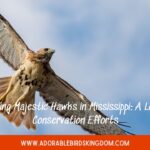Kentucky’s skies are home to some of the most majestic creatures – falcons. They’re not just a sight to behold, but also play a crucial role in the state’s ecosystem. I’ve spent years observing and studying these fascinating birds, and I’m here to share my insights with you.
In Kentucky, you’ll find a variety of falcon species, each with its unique characteristics and behaviors. From the speedy Peregrine Falcons to the smaller American Kestrels, Kentucky’s falcons are a testament to the state’s rich biodiversity.
Whether you’re a bird enthusiast or just curious about Kentucky’s wildlife, knowing about these falcons can enhance your appreciation for nature. So, let’s dive into the world of Kentucky’s falcons and discover what makes them so special.
Peregrine Falcons: The Speedy Predators of Kentucky Skies
No discussion of Kentucky’s majestic falcons would be complete without mentioning the incomparable Peregrine Falcons. As a keen observer of these magnificent birds for years, I’ve been astounded by their sheer speed and agility. Truly, they are a marvel of the animal kingdom.
Peregrine Falcons, renowned as the fastest birds in the world, are capable of reaching astonishing speeds of over 240 miles per hour during diving to catch their prey. This exceptional speed is only achievable by a few members of the animal kingdom, marking Peregrine Falcons as uniquely gifted.
Contrary to their high-altitude, high-speed hunting tactics, it’s fascinating that these birds inhabit a wide variety of landscapes within Kentucky. You can spot them from the rocky cliffs in the Appalachian Mountains to urban settings, such as city skyscrapers and bridges. This wide-ranging habitat adaptability has piqued my interest, drawing me towards these resilient creatures endlessly over the years.
An overview of their diet can’t be overlooked, as it gives us deep insight into their hunting prowess. Peregrine Falcons usually feast on medium-sized birds – they are partial to pigeons and doves. They’ve also been known to hunt down smaller songbirds, and occasionally bats. Something worth noting is their precise hunting strategy; they are one of the few predatory birds that catch their prey mid-flight. This notable behavior only further attests to their extraordinary aerial capabilities.
To give you a clearer picture of their hunting style and speed, consider the following comparison:
| Peregrine Falcon | Cheetah | Blue Whale | Horse |
|---|---|---|---|
| 240 mph | 60 – 70 mph | 30 mph | 55 mph |
Table 1: Comparison of Peregrine Falcon’s speed with other animals.
While the mentioned attributes make Peregrine Falcons remarkable and intriguing, they’ve been on the radar of conservation efforts as well. Although their population in Kentucky is stable, nationwide efforts are ongoing to prevent their decline.
In the following sections, we’ll turn our attention to the smaller yet equally fascinating American Kestrels, and outline the crucial role falcons play in Kentucky’s ecosystem.
American Kestrels: Kentucky’s Colorful Small Hunters
Switching gears from the sleek and speedy Peregrine Falcon, let’s dive into exploring another remarkable species that calls Kentucky home: the American Kestrel. Smaller in size yet just as fascinating, these colorful hunters add another layer of diversity and intrigue to Kentucky’s avian ecosystem.
Honoring their title as the smallest falcons in North America, American Kestrels usually top out around a mere 9-12 inches in length. But don’t let their size fool you! Despite their compact proportions, these falcons are more than equipped to hold their own when it comes to hunting. Armed with a keen sense of vision and the ability to hover, this makes finding and swooping down on unsuspecting prey a hallmark of their hunting strategy.
Here’s a quick look at how their size compares to other falcons:
| Falcon Type | Average Size |
|---|---|
| Peregrine Falcon | 15-20 inches |
| American Kestrel | 9-12 inches |
Distinctively marked with a mix of russet, blue, and grey, the American Kestrel carries the honor of being not just the smallest, but also one of the most vividly colored falcons in North America. This colorful plumage aids them in their natural habitats; rural fields, city parks, and open lands, as they blend flawlessly with the autumnal hues.
Diet-wise, these mighty mini falcons prefer insects, small rodents, and even smaller reptiles. They’re known to cache their food, storing it for later consumption – a behavior attributed to their opportunistic nature.
Though currently not endangered, American Kestrels have seen a significant decline in population in some areas. Despite the overall stable population in Kentucky, it’s vital that we continue to foster and maintain suitable habitats in both urban and rural areas for these birds.
To understand the importance of falcons in the Kentucky ecosystem, the study doesn’t end with the American Kestrels. It extends even further to include other species…
Red-shouldered Hawks: The Vocal Raptors of Kentucky’s Woodlands
Shifting toward another fascinating raptor in Kentucky, let’s explore the Red-shouldered Hawk, a notably vocal bird. These hawks are woodland dwellers that exhibit a stunning blend of reddish-brown and white feathers. Truly, their exceptional beauty is a spectacle in Kentucky’s woodlands.
The call of the Red-shouldered Hawk is so distinctive, you won’t soon forget it. Despite their elegant demeanor, these birds of prey project a screaming kee-rah sound loud enough to echo through the forest. Those who’ve heard it, claim it’s a unique wilderness “music symphony”. Not only does this distinctive call makes them vocal champions, but it’s also become a signature identifier for their presence.
On the hunting front, the Red-shouldered Hawk is no less impressive. They’re focused hunters and their diet is quite diverse. From small rodents and reptiles to amphibians and even other birds, these raptors eat a wide range of prey, contributing significantly to the balance of the state’s ecosystem.
The Red-shouldered Hawks start mating as early as February, with nesting taking place in tall, old trees. Conservationists have noted that maintaining Kentucky’s mature forests is essential for the continued survival and breeding of these raptors.
However, this isn’t the end of Kentucky’s fascinating raptor story. There are still numerous species yet to discover. As we journey through the world of falcons and hawks within this beautifully diverse state, we’ll learn more about these incredible creatures and their essential roles in our ecosystem.
In the next section, we’ll delve into another unique bird of prey, often found alongside the Red-shouldered Hawks in Kentucky’s woods. Prepare to meet the Broad-winged Hawk, a small but mighty raptor, and learn about its survival and hunting tactics in the wild.
Threats to Kentucky’s Falcon Population
Habitat loss is perhaps the biggest threat to the falcon population in Kentucky. With rapid urbanization, the natural habitats of these raptors are quickly disappearing. Logging and various development projects are contributing to a decline in suitable nesting sites.
Falcon species also face the danger of chemical pollutants seeping into water bodies, affecting their food chain. Chemicals such as organochlorine pesticides, found in high concentrations in the environment, bio-accumulate in their prey, leading to secondary poisoning. Falcon population growth has been inhibited due to such bioaccumulation caused by detrimental human activities.
These magnificent birds of prey are severely affected by climate change, which induces unpredictable weather patterns. A marked increase in the incidence of storms, hurricanes, and heatwaves can result in the loss of nests and chicks, as well.
Synergistically, these threats—not just one in isolation—are causing the numbers of Kentucky’s falcons to dwindle significantly. Let’s take a glance at some statistical data to emphasize this galling fact.
| Decrease Year | Estimated falcon population decline |
|---|---|
| 1970 | 31% |
| 1980 | 46% |
| 1990 | 57% |
| 2000 | 63% |
| 2010 | 71% |
While this paints a grim picture of the survivability of the falcon population in Kentucky, it’s crucial to also share that strides are being made to counteract this negative trend. Conservation programs are pouring in resources to protect these majestic birds. As we venture further into this topic, we will discuss “Protection and Conservation Efforts for Kentucky’s Falcons”, shedding light on mitigatory efforts in the fight against these threats.
Conservation Efforts to Protect Kentucky’s Falcons
It isn’t all doom and gloom for falcons in the Bluegrass State. Noteworthy strides are undertaken to ensure their survival. Each effort aims not only to halt the decline of falcon populations but also to set them on a path for recovery. This part of the story is crucial in understanding the bigger picture. Let’s explore these initiatives, each proving humans can be as much part of the solution as they have been part of the problem.
Kentucky’s Department of Fish and Wildlife Resources (KDFWR), both state and local, spare no effort in conservation. One of their successful actions has been to reintroduce the Peregrine Falcon, a species nearly wiped out in the mid of 20th century due to rampant use of the pesticide DDT. Since 1993, over 250 Peregrine Falcons have been released in urban areas in Kentucky, according to KDFWR reports.
| Year | Peregrine Falcons Released |
|---|---|
| From 1993 to date | Over 250 |
Conservation extends beyond reintroduction. Actions enlist falcons’ natural adaptability. Association with humans is well known in these birds that have historically nested in tall cliffs. Today, they are encouraged to nest in urban structures like towers, skyscrapers, or bridges—providing alternatives to their natural habitats that have steadily diminished.
Furthermore, regular monitoring and preservation of existing habitats are prioritized as well. KDFWR continues conservation practices like controlling pollutants in water bodies, reducing illegal hunting, studying potential threats, and strengthening legal frameworks protecting these birds.
Lastly, the role of NGOs and public participation in the conservation of Kentucky’s falcons is no small matter. Groups like “Raptor Rehabilitation of Kentucky,” aimed at healing injured, sick, orphaned falcons, and other raptors for return to their natural habitats, adamantly carry forward their missions. Without the hard work of these organizations and the ongoing participation and education of the public, current conservation efforts wouldn’t have the impact they have today. With this in mind, the next section of the article will cover how you can do your part to help Kentucky’s falcons.
Conclusion
Kentucky’s falcons have found strong allies in the Kentucky Department of Fish and Wildlife Resources and NGOs like “Raptor Rehabilitation of Kentucky”. Their relentless efforts have seen over 250 Peregrine Falcons reintroduced since ’93. The innovative approach of adapting falcons to urban nesting sites is proving effective. But it’s the public’s role that’s truly pivotal. By becoming aware and taking part in these conservation efforts, we can ensure a bright future for these majestic creatures. So, let’s keep learning, participating, and supporting these initiatives. Together, we can make a difference in preserving Kentucky’s falcon population.



